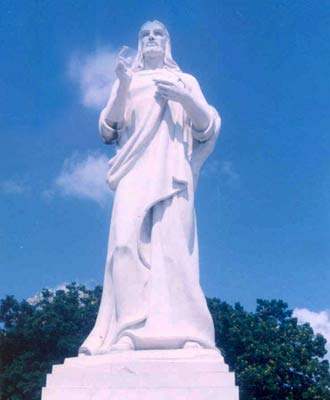Privatizing Christ?
Daisy Valera

From the position where the Christ of Havana is situated, one has a panoramic view of the historical part of the city.
This 66-foot-high sculpture was sculpted in white Carrara marble in Rome by Cuban artist Jilma Madera and shipped to the island in 67 pieces.
To those who visit or live in the capital, she bequeathed it as one of largest sculptures ever created by a woman.
This Christ figure that blesses the Cuban capital, 167 feet above sea level, is a customary tourist destination.
To sit down and rest near its giant feet after climbing the Cabaña hillside has always been a normal and pleasant activity for me.
What was equally pleasurable was waiting for the sun to set on the bay and enjoying a view of Havana by night while sitting on one of the marble benches that surround the colossal figure.
But I say that this in the past tense — because all this changed yesterday afternoon.
I went to the Christ statue together with three friends, but we were stopped two yards from the figure. We were asked for entry tickets though we didn’t know what they were talking about and didn’t see anything that looked like an entrance, and much less did we know where they sold the damned tickets.
The attendants immediately explained to us that to be in that place (I had no clear idea of the limits and nor were they able to show them to me) we had to buy tickets for one Cuban peso (or one convertible peso for foreigners).
They were charging us for visiting the site and for taking photos, which we couldn’t believe.
We went to the admissions collections booth where they told us that this charging has been in operation for a year, a fact that can’t be totally true because last week they didn’t ask me for anything.

They now say they’re charging for visiting the Christ statue because it’s part of the historic Morro-Cabaña military complex.
We left there more than a little upset, and we weren’t the only ones; a man who came with his family also refused to pay.
Anyone might tell me that a Cuban peso is a pittance, that for the same price you can only buy a watery cup of coffee or a small cone of peanuts.
I’d respond by saying that this is true, that it’s a fact that one peso less in one’s pocket doesn’t make too much of a difference, but I’d say that if they wanted to charge me only 20 cents I’d complain just as much.
What immediately came to my mind were the privatizations that took place in Argentina under the Menem government. Parks, squares and sports facilities were removed from the list of public property for which that country’s citizens had worked so hard.
The initiative here, far from socializing the enjoyment of the facility by the public, is a step toward its privatization.
Perhaps if this step had been limited to charging foreigners I wouldn’t have become incensed in the same way, but to me — a Cuban — this is without discussion a violation of my rights as a citizen.
What will less advantaged people do in the face of this act of exclusion?
Are they also going to start charging me in the square where I jog?
Surely the person who authorized this little scam didn’t keep in mind the “socialist character” of the Revolution.
I honestly invite this individual to reflect on this matter. Dear Lord, let’s hope that not everything will be directed toward increasing profits, unless you too are studying to become a capitalist.






I have two thoughts …
First, if a government official can think of taxing something, that government will try and tax it. It is true of all governments, whether socialist, dictatorial, or democratic. We are having similar kinds of issues in the USA, where the economic problems have caused tax receipts to drop.
Second, there is logic to the idea of taxing use of the park in order to pay for the maintenance of the park. If the entry tax is insignificant individually, but there are enough visitors to raise significant funds, then by one interpretation it is very fair. Those who value the park and use the park pay for it’s upkeep. Those who don’t value it and don’t use it don’t have to pay for it.
hola,
I liked what you wrote and I understand, even though Im Norwegian. Si tu quieres escribe me?
Well Daisy it looks like there is an element of Capitalism in what has transpired. As you say, it is only one peso but there is a principle here.
Personally as a visitor I would have no objection to paying a nominal fee (considerably more than one peso) if it meant that Cubans continued to visit for free.
As a citizen/resident of the UK, we are still in denial about being a capitalist country and your article has reminded me of what occurred in the 1990’s. Our seat of the Church of England is Canterbury Cathedral in Kent which is visited by millions each year from around the World. It was decided 9or decreed) that people should be charged not just for visiting the Cathedral but walking through the grounds. There was and still is a loophole to the charge and that is if the individual is carrying a Bible or states to the ‘sentry’ that they are going to pray they may waive the charge.
Church going has been on the decline for a number of years in the UK and rather than encourage people to a place of worship, they flex their capitalist muscles and tell their ‘flock’ they must pay for the privelege.
Sounds very familiar.
Kind regards,
Terence